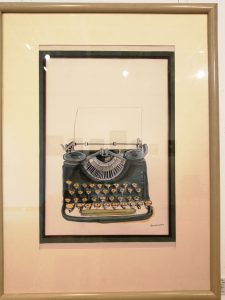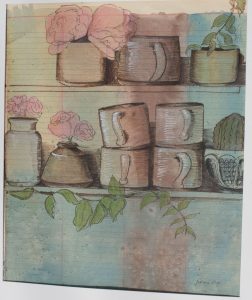Jasleena Singh’s work evolved from kitsch art toward a more subtle palette and she juxtaposes daily use objects in a different environment or a background and these elegant compositional style is the essence of her work through these simple elements of daily use. The term still life is itself is a contradiction, for life is never still and things in this world refuse to sit still. Perhaps the illusory glory of the realistic image perfectly painted and its implicit ageless quality accounts for its appeal in art.
Her works ooze the nostalgia for a slow paced urban life and its everyday affairs. These still lives are no exception as it delineates the most mundane objects like the lamps, gramophone or a simple cane chair, representing intrinsic domesticity. The background or the negative space also acts as a time capsule for the main form. Sometimes it is contemporary, the painting at that instant contains two time zones together, and at times the object or the main-form (positive space) is from the past and the background (negative space) from the contemporary time zone. Symbolism is writ large in these works- it takes us back to when symbolist’ poetry was closely aligned with aesthetic and decadent styles: when poets and artists aimed to explore the beauty of strange, subjective and unique moments. The post box is a relic of the past with its rusted iron and burnt sienna tonality. In an age of technology, the cell phone, era and the lap top and email, the post box looks like an ancient relic confined to the past.
“Such objects exist to be our superstructures like our monuments as a reminder of an era where all this was an essential part,” says Jasleena. “Through this body of work I am trying to portray the rich legacy and cultural history of our bygone era, while showing the displacement and migration, which was hence brought to independence after a huge long struggle.”
The body of work created is fuelled with old school styling and day-to-day instruments. This work is about the daily use objects, which are now rarely used. These works include her very own personal take on art with joy and pastel shades and they range from literal interpretations to metaphorical synthesis, these paintings incorporate dreams, emotions and expressions that influence her work. Small details like triangles appear and disappear in transparent veils of muted hues that press toward and away from the picture plane. Black lines zigzag playfully across the page, creating scalene triangles in soft hues. Translucent layers of aqueous browns cover large areas of the compositions, delineating small forms like flowers, cups, a gramophone or even a cane chair . About her art forms it can be said that she has achieved formal tension here by combining soft, barely-there atmospheric colour with resolute, geometric clarity. The abstracted fragmented forms seek to create counterpoints in the arrangement of aesthetics and grammar in techniques. Ultimately it’s about the idea of decadence that calls for a spotlight on its past and its solitary existence even as it lies forgotten yet a part of one’s lifestyle irrespective of the life it had more than perhaps as long as 50 or 60 years ago.




